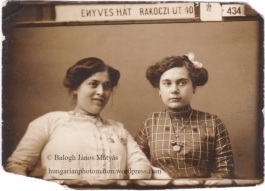János Mátyás BALOGH:
Stickyback and Photomaton: Trends in Portrait Photography in the First Decades of the Twentieth Century
– ABSTRACT –
The study, publishing the first findings of an international basic research project, describes the technology behind the so-called Stickyback Photography and the Photomaton photobooth, with special attention to their corporate background and social use.
The paper is the first to point out that the Phenomenon of the Stickyback Photography, a term coined by the author to describe cheap, small identical portraits printed on strips of twelve, coexisted in several countries at the same time: besides a number of other countries, it was known as “Stickyback” in the UK, “enyveshát” (i.e. ‘sticky back’) in Hungary, “Leimrücken” (i.e. ‘sticky back’) in Austria, “American Automatic Photo” in Germany, Belgium, and the Netherlands (also known as “tip top” in the latter), and “photo mécanique” in France. This fact, however, is seemingly absent both from the history of photography in specific countries, and from international scholarship in the field. Besides the lack of international context, this also led some scholars to incorrectly identify these photos as direct positive photography or photobooth images. On the contrary, the 1911-1912 continental spread of Stickyback Photography, which existed in England as early as the first couple of years of the twentieth century, was in fact the adaptation of this technical and technological know-how in a number of countries. The founder of the first Stickyback shop in Budapest was the cousin of the owner of the Brighton office, the new business model was then taken to Vienna by Hungarian entrepreneurs, whence the phenomenon reached the German, Dutch, Belgian and French markets. This trend in portrait photos flourished in the continent in the 1910s, and its representatives included both individuals and regional or international enterprises. Certain varieties of Stickyback photographs had an adhesive coating on the back, in other countries the clients were given the illusion of automatism by pressing a button to snap the photo themselves.
Anatol Josepho’s invention, the Photomaton photobooth – patent applied in 1923/1925 in New York – was, however, genuinely automatic. The machine was capable to make a series of 6 or 8 different photos on a paper strip within a few minutes. The Photomaton was not simply an invention, but an international brand promoted by an expertly managed and widely disseminated media campaign. For the first time in scholarship, the paper tracks the development of this “world conqueror” business chain, even embroiled in stock market speculation, from the time when the first company was launched some time before achieving world fame, until its demise when the Photomaton-bubble burst in September 1929. Josepho’s Photomaton was, in many respects, similar to Stickyback Photography, especially the format and the “nature” of the product and its whirlwind international spread, peppered with occasional cases of insolvency. In addition both were used by the widest possible layers of society and both became a source of entertainment besides their practical use to take ID photographs.
The common denominator behind these two influential – yet unknown or wrongly identified – portrait photography trends was the very inventor of the Photomaton. Now identified for the first time by his original name, he was the same person who, from 1913 onwards, worked in his cousin’s company, the first Hungarian Stickyback shop. This is where he submitted his first patent for a rather basic photo automaton. The initial backers and investors of the Photomaton included several members of his Russian-born American family, which is an overlooked detail in his story. Understanding his support network certainly nuances the inventor’s heroic “self-made man” image created by contemporary media, which subsequently made its way into modern scholarship as well.
* * *
The full article was published [in Hungarian] in December 2018:
Balogh János Mátyás: Stickyback és Photomaton: portréfotó-divatok a 20. század első évtizedeiben. Korall [Hungarian Journal for Social History] Issue No. 73 (2018) p. 79-111.

“Enyveshát” – the Hungarian variant of Stickyback Photography
(Margit Siposs and her friend; Budapest, 1911/1912; Photo made by a cousin of Anatol Josepho; 4 x 6 cm)
© Collection of János Mátyás Balogh


Ajánlott bejegyzések:
A bejegyzés trackback címe:
Kommentek:
A hozzászólások a vonatkozó jogszabályok értelmében felhasználói tartalomnak minősülnek, értük a szolgáltatás technikai üzemeltetője semmilyen felelősséget nem vállal, azokat nem ellenőrzi. Kifogás esetén forduljon a blog szerkesztőjéhez. Részletek a Felhasználási feltételekben és az adatvédelmi tájékoztatóban.